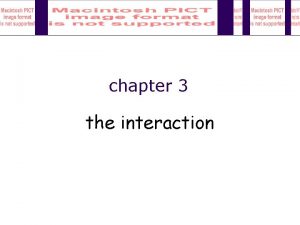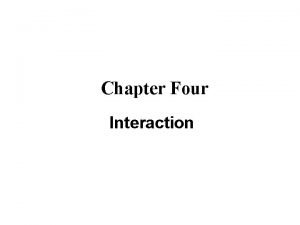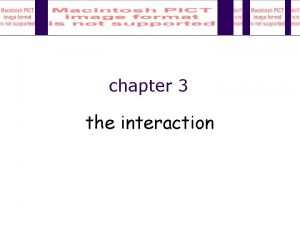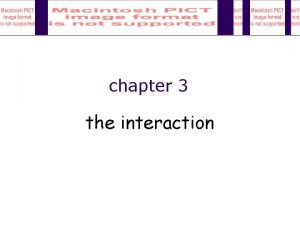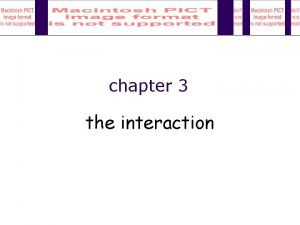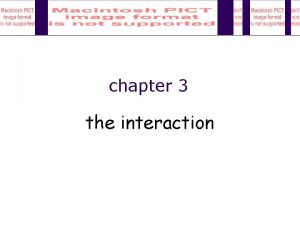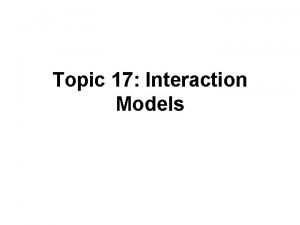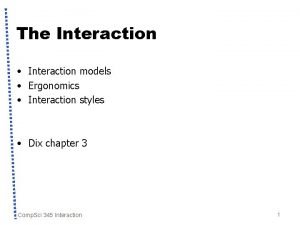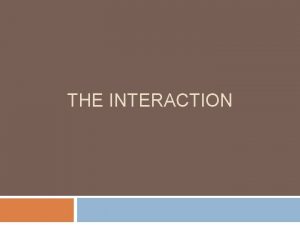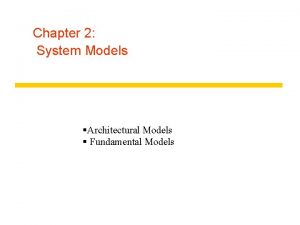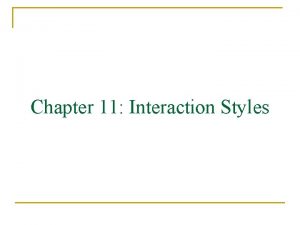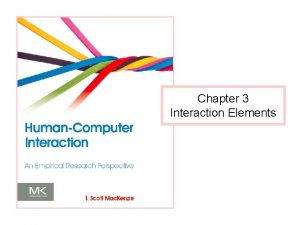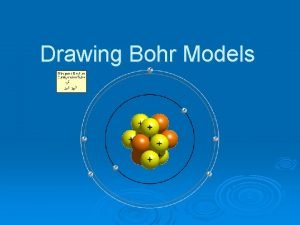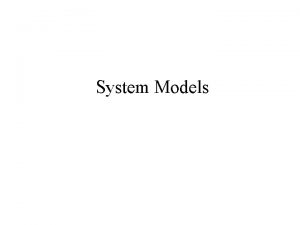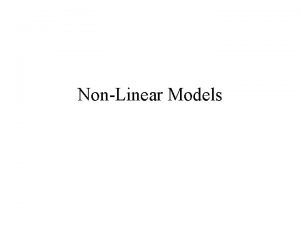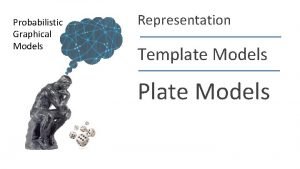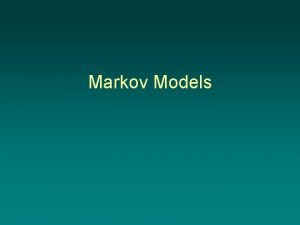chapter 3 the interaction The Interaction interaction models




































- Slides: 36

chapter 3 the interaction

The Interaction • interaction models – translations between user and system • ergonomics – physical characteristics of interaction • interaction styles – the nature of user/system dialog

models of interaction terms of interaction Norman model

Some terms of interaction domain – the area of work under study e. g. graphic design goal – what you want to achieve e. g. create a solid red triangle task – how you go about doing it – ultimately in terms of operations or actions e. g. … select fill tool, click over triangle

Donald Norman’s model • Seven stages – – – – user establishes the goal formulates intention specifies actions at interface executes action perceives system state interprets system state evaluates system state with respect to goal • Norman’s model concentrates on user’s view of the interface

execution/evaluation loop goal execution evaluation system • • user establishes the goal formulates intention specifies actions at interface executes action perceives system state interprets system state evaluates system state with respect to goal

execution/evaluation loop goal execution evaluation system • • user establishes the goal formulates intention specifies actions at interface executes action perceives system state interprets system state evaluates system state with respect to goal

execution/evaluation loop goal execution evaluation system • • user establishes the goal formulates intention specifies actions at interface executes action perceives system state interprets system state evaluates system state with respect to goal

execution/evaluation loop goal execution evaluation system • • user establishes the goal formulates intention specifies actions at interface executes action perceives system state interprets system state evaluates system state with respect to goal

execution/evaluation loop goal execution evaluation system • • user establishes the goal formulates intention specifies actions at interface executes action perceives system state interprets system state evaluates system state with respect to goal

ergonomics physical aspects of interfaces industrial interfaces

Ergonomics • Study of the physical characteristics of interaction • Also known as human factors – but this can also be used to mean much of HCI! • Ergonomics good at defining standards and guidelines for constraining the way we design certain aspects of systems

Ergonomics - examples • arrangement of controls and displays e. g. controls grouped according to function or frequency of use, or sequentially • surrounding environment e. g. seating arrangements adaptable to cope with all sizes of user • health issues e. g. physical position, environmental conditions (temperature, humidity), lighting, noise, • use of colour e. g. use of red for warning, green for okay, awareness of colour-blindness etc.

interaction styles dialogue … computer and user distinct styles of interaction

Common interaction styles • • command line interface menus natural language question/answer and query dialogue form-fills and spreadsheets WIMP point and click three–dimensional interfaces

Command line interface • Way of expressing instructions to the computer directly – function keys, single characters, short abbreviations, whole words, or a combination • • suitable for repetitive tasks better for expert users than novices offers direct access to system functionality command names/abbreviations should be meaningful! Typical example: the Unix system

Menus • Set of options displayed on the screen • Options visible – less recall - easier to use – rely on recognition so names should be meaningful • Selection by: – numbers, letters, arrow keys, mouse – combination (e. g. mouse plus accelerators) • Often options hierarchically grouped – sensible grouping is needed • Restricted form of full WIMP system

Natural language • Familiar to user • speech recognition or typed natural language • Problems – vague – ambiguous – hard to do well! • Solutions – try to understand a subset – pick on key words

Query interfaces • Question/answer interfaces – user led through interaction via series of questions – suitable for novice users but restricted functionality – often used in information systems • Query languages (e. g. SQL) – used to retrieve information from database – requires understanding of database structure and language syntax, hence requires some expertise

Form-fills • • Primarily for data entry or data retrieval Screen like paper form. Data put in relevant place Requires – good design – obvious correction facilities

Spreadsheets • first spreadsheet VISICALC, followed by Lotus 1 -2 -3 MS Excel most common today • sophisticated variation of form-filling. – grid of cells contain a value or a formula – formula can involve values of other cells e. g. sum of all cells in this column – user can enter and alter data spreadsheet maintains consistency

WIMP Interface Windows Icons Menus Pointers … or windows, icons, mice, and pull-down menus! • default style for majority of interactive computer systems, especially PCs and desktop machines

Point and click interfaces • used in. . – multimedia – web browsers – hypertext • just click something! – icons, text links or location on map • minimal typing

Three dimensional interfaces • virtual reality • ‘ordinary’ window systems – highlighting – visual affordance – indiscriminate use just confusing! flat buttons … click me! • 3 D workspaces – use for extra virtual space – light and occlusion give depth – distance effects … or sculptured

elements of the wimp interface windows, icons, menus, pointers +++ buttons, toolbars, palettes, dialog boxes

Windows • Areas of the screen that behave as if they were independent – can contain text or graphics – can be moved or resized – can overlap and obscure each other, or can be laid out next to one another (tiled) • scrollbars – allow the user to move the contents of the window up and down or from side to side • title bars – describe the name of the window

Icons • small picture or image • represents some object in the interface – often a window or action • windows can be closed down (iconised) – small representation fi many accessible windows • icons can be many and various – highly stylized – realistic representations.

Pointers • important component – WIMP style relies on pointing and selecting things • uses mouse, trackpad, joystick, trackball, cursor keys or keyboard shortcuts • wide variety of graphical images

Menus • Choice of operations or services offered on the screen • Required option selected with pointer problem – take a lot of screen space solution – pop-up: menu appears when needed

Kinds of Menus • Menu Bar at top of screen (normally), menu drags down – pull-down menu - mouse hold and drag down menu – drop-down menu - mouse click reveals menu – fall-down menus - mouse just moves over bar! • Contextual menu appears where you are – pop-up menus - actions for selected object – pie menus - arranged in a circle • easier to select item (larger target area) • quicker (same distance to any option) … but not widely used!

Menus extras • Cascading menus – hierarchical menu structure – menu selection opens new menu – and so in ad infinitum • Keyboard accelerators – key combinations - same effect as menu item – two kinds • active when menu open – usually first letter • active when menu closed – usually Ctrl + letter usually different !!!

Menus design issues • which kind to use • what to include in menus at all • words to use (action or description) • how to group items • choice of keyboard accelerators

Buttons • individual and isolated regions within a display that can be selected to invoke an action • Special kinds – radio buttons – set of mutually exclusive choices – check boxes – set of non-exclusive choices

Toolbars • long lines of icons … … but what do they do? • fast access to common actions • often customizable: – choose which toolbars to see – choose what options are on it

Dialogue boxes • information windows that pop up to inform of an important event or request information. e. g: when saving a file, a dialogue box is displayed to allow the user to specify the filename and location. Once the file is saved, the box disappears.

Homework 3 1. What is a WIMP interface? Compare it with a new HCI interface (such as touch-screen interface, i. Pad). List their pros and cons. 2. What is 8 pen? Do you think it will become a future trend? Why (or not)? View this video. 3. Use Don Norman's seven-stage model of interaction to explain the process of interaction when you use Lion. Path to request your transcripts.
 Modals and semi-modals
Modals and semi-modals Modelling rich interaction
Modelling rich interaction Hình ảnh bộ gõ cơ thể búng tay
Hình ảnh bộ gõ cơ thể búng tay Ng-html
Ng-html Bổ thể
Bổ thể Tỉ lệ cơ thể trẻ em
Tỉ lệ cơ thể trẻ em Chó sói
Chó sói Thang điểm glasgow
Thang điểm glasgow Hát lên người ơi alleluia
Hát lên người ơi alleluia Môn thể thao bắt đầu bằng từ đua
Môn thể thao bắt đầu bằng từ đua Thế nào là hệ số cao nhất
Thế nào là hệ số cao nhất Các châu lục và đại dương trên thế giới
Các châu lục và đại dương trên thế giới Cong thức tính động năng
Cong thức tính động năng Trời xanh đây là của chúng ta thể thơ
Trời xanh đây là của chúng ta thể thơ Cách giải mật thư tọa độ
Cách giải mật thư tọa độ Làm thế nào để 102-1=99
Làm thế nào để 102-1=99 độ dài liên kết
độ dài liên kết Các châu lục và đại dương trên thế giới
Các châu lục và đại dương trên thế giới Thơ thất ngôn tứ tuyệt đường luật
Thơ thất ngôn tứ tuyệt đường luật Quá trình desamine hóa có thể tạo ra
Quá trình desamine hóa có thể tạo ra Một số thể thơ truyền thống
Một số thể thơ truyền thống Cái miệng bé xinh thế chỉ nói điều hay thôi
Cái miệng bé xinh thế chỉ nói điều hay thôi Vẽ hình chiếu vuông góc của vật thể sau
Vẽ hình chiếu vuông góc của vật thể sau Nguyên nhân của sự mỏi cơ sinh 8
Nguyên nhân của sự mỏi cơ sinh 8 đặc điểm cơ thể của người tối cổ
đặc điểm cơ thể của người tối cổ Thứ tự các dấu thăng giáng ở hóa biểu
Thứ tự các dấu thăng giáng ở hóa biểu Vẽ hình chiếu đứng bằng cạnh của vật thể
Vẽ hình chiếu đứng bằng cạnh của vật thể Tia chieu sa te
Tia chieu sa te Thẻ vin
Thẻ vin đại từ thay thế
đại từ thay thế điện thế nghỉ
điện thế nghỉ Tư thế ngồi viết
Tư thế ngồi viết Diễn thế sinh thái là
Diễn thế sinh thái là Dạng đột biến một nhiễm là
Dạng đột biến một nhiễm là Thế nào là số nguyên tố
Thế nào là số nguyên tố Tư thế ngồi viết
Tư thế ngồi viết Lời thề hippocrates
Lời thề hippocrates





































